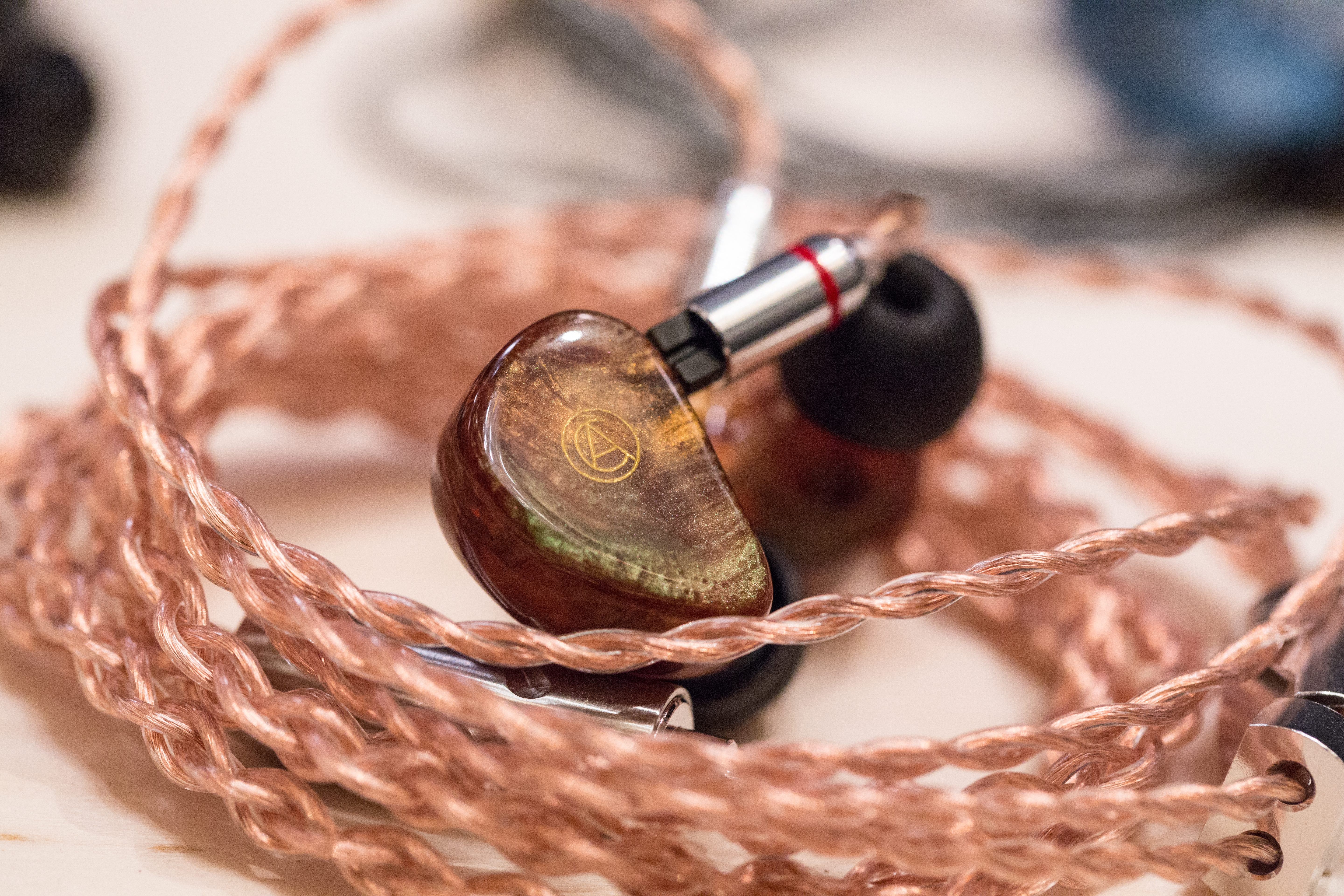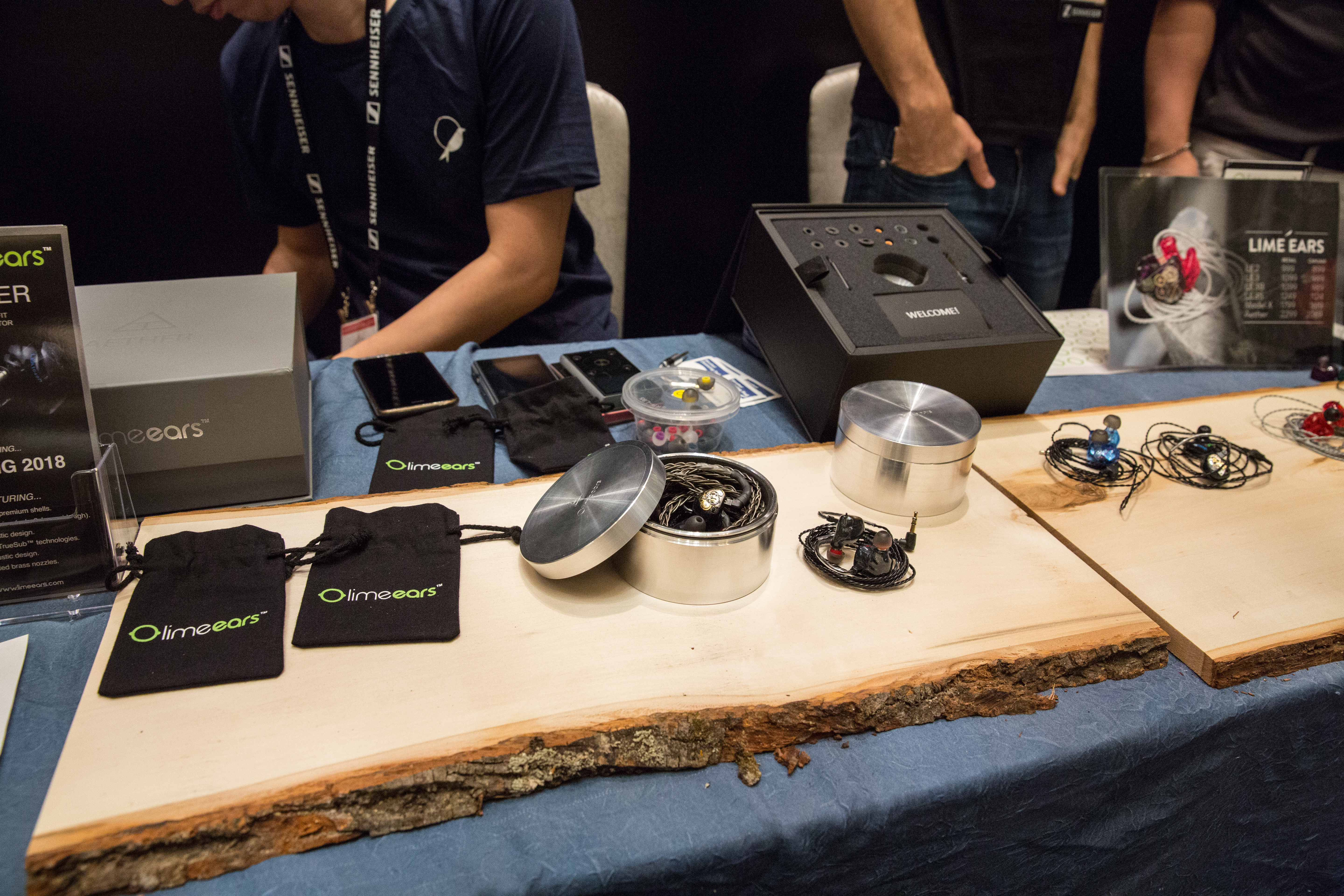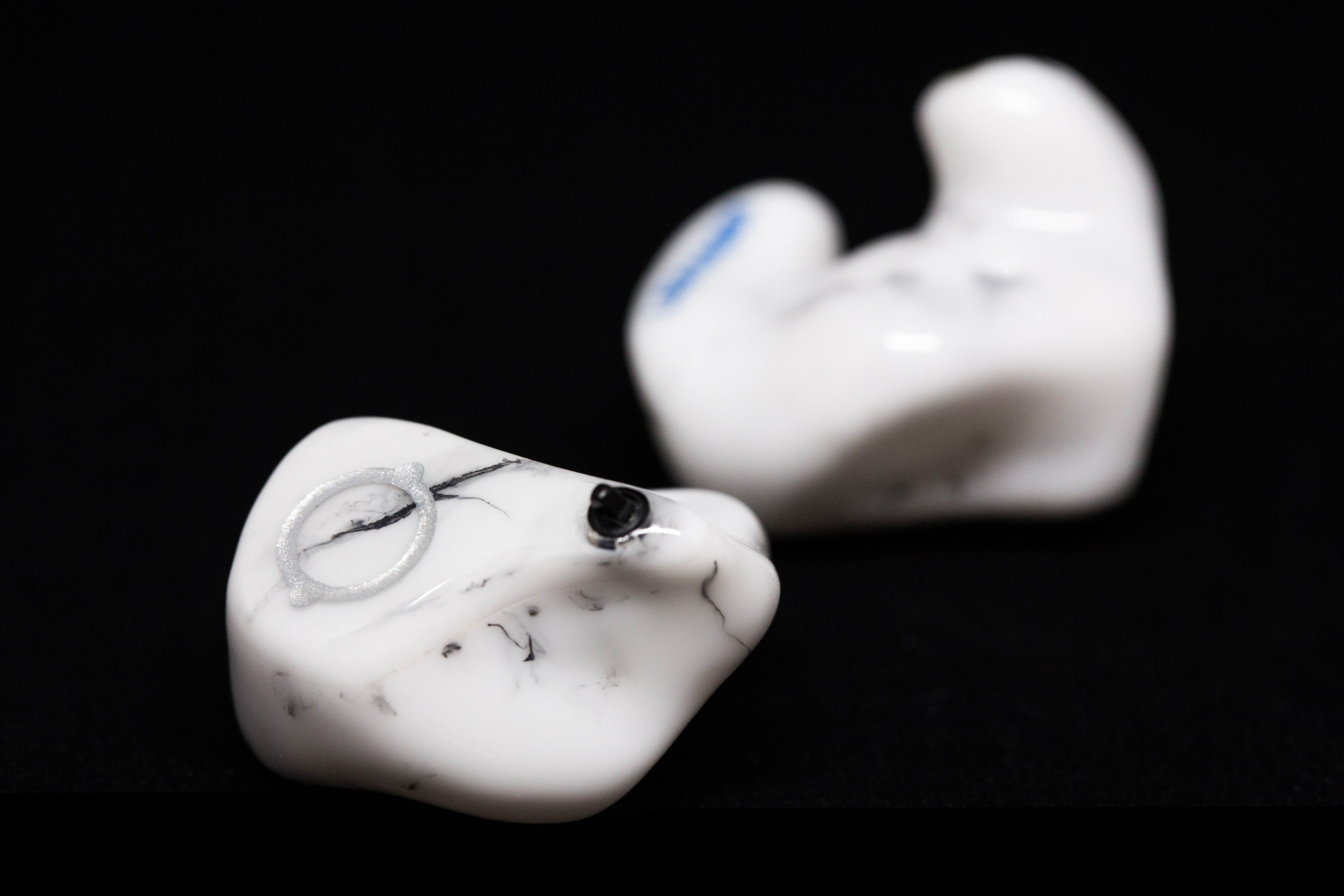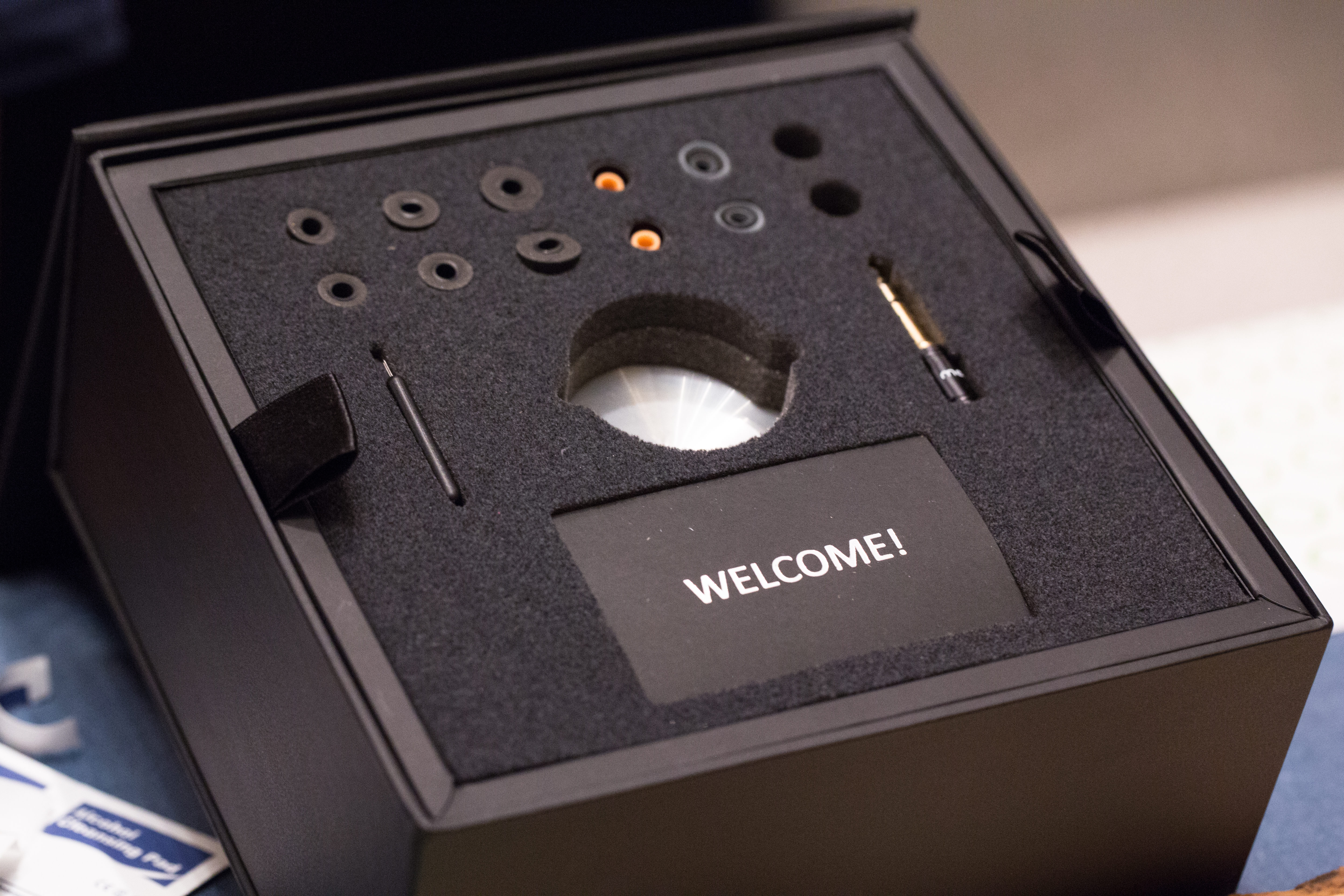Custom Art
Also present at Music Sanctuary’s treasure trove of trinkets were two Polish manufacturers that I’ve had the absolute pleasure of working with time and time again on the site: Piotr Granicki of Custom Art and Emil Stolecki of Lime Ears. I visited the former first and auditioned his brand new product – the FIBAE Massdrop Edition. It’s a six-driver IEM with a bass-oriented signature, equipped with Custom Art’s innovative FIBAE technology designed to maintain the monitor’s signature regardless of source. Our very own Pinky Powers will be reviewing the custom variant of the FIBAE ME soon.
 Custom Art FIBAE Massdrop Edition: The FIBAE ME was designed with an emphasis in the low-end to produce a warm, rich and pleasing sonic palate. Although the entire bass region itself is elevated, Piotr has tuned it specifically to emulate the physicality and air of a dynamic driver. Bolstered by a rise from the sub-bass all throughout the mid-bass, the ME achieves this successfully – simulating the viscerality and decay that certainly evokes a driver of this kind. And, this low-end warmth serves a double purpose; also adding richness and body into the midrange. The ME’s lower-midrange is attenuated to compensate for this, maximising the low-end’s harmonic richness without congestion or bloat.
Custom Art FIBAE Massdrop Edition: The FIBAE ME was designed with an emphasis in the low-end to produce a warm, rich and pleasing sonic palate. Although the entire bass region itself is elevated, Piotr has tuned it specifically to emulate the physicality and air of a dynamic driver. Bolstered by a rise from the sub-bass all throughout the mid-bass, the ME achieves this successfully – simulating the viscerality and decay that certainly evokes a driver of this kind. And, this low-end warmth serves a double purpose; also adding richness and body into the midrange. The ME’s lower-midrange is attenuated to compensate for this, maximising the low-end’s harmonic richness without congestion or bloat.
Also a key player in this regard is an upper-midrange peak. The FIBAE ME employs an 8-9 kHz peak that heavily resembles the one found in their flagship Harmony 8.2. This peak aids vocal articulation and effectively prevents any excess bloat coming from the low-end. This is then capped off with a warm top-end and a relatively linear upper-treble – solidifying the ME’s mellow and organic signature. But, due to impressive treble extension, the FIBAE ME has one of the most impressive soundstages Custom Art has ever put out. Although it is inherently full-sounding because of its elevated low-end, the ME is equipped with more than enough headroom to create a spacious environment – expanding admirably in width and decently in depth to create an engaging-yet-easygoing soundscape.
Lime Ears
After I finished noting down my impressions of the FIBAE ME, I scooted over to the table at my right where I was greeted joyfully by the ever-eccentric and ever-groovy Emil Stolecki. Although he’s still deep in development as far as new products are concerned, he did bring – to my pleasant surprise – brand new packaging for the universal variant of the Aether and my very own Model X review unit! To be completely honest, I was happier to see the former than the latter – packaging is a very important aspect of product design to me – but that opinion only lasted the few seconds it took to get the Model X’s into my ears, because these things sound phenomenal!
 Lime Ears Model X: After writing my very first THL review on the Lime Ears Aether, I reached out to Emil about doing one on the Model X. And, Emil finally bequeathed them to me here, months later. The reason why it took so long to produce is the unique shell design. Inspired by the elegant textures of marble, Emil and his team toiled hard to produce a similarly classy swirl. I think it’s safe to say they’ve done a pretty stellar job. Compared to my Aether’s, the Model X’s are infinitely more ergonomic. The Aether – love ‘em to death – are still the tightest customs I own. These marbled jewels, on the other hand, are two of the most comfortable, low-profile and seamless I’ve ever experienced. They are an absolute joy to wear, and they only go to show how far Emil and his team have come within the past couple years.
Lime Ears Model X: After writing my very first THL review on the Lime Ears Aether, I reached out to Emil about doing one on the Model X. And, Emil finally bequeathed them to me here, months later. The reason why it took so long to produce is the unique shell design. Inspired by the elegant textures of marble, Emil and his team toiled hard to produce a similarly classy swirl. I think it’s safe to say they’ve done a pretty stellar job. Compared to my Aether’s, the Model X’s are infinitely more ergonomic. The Aether – love ‘em to death – are still the tightest customs I own. These marbled jewels, on the other hand, are two of the most comfortable, low-profile and seamless I’ve ever experienced. They are an absolute joy to wear, and they only go to show how far Emil and his team have come within the past couple years.
Sonically, the Model X is a clear cousin to the Aether – sharing its smooth, airy and oh-so-charming tonality – whilst cutting back on the bass in exchange for a more present midrange. Even with the bass switch up, the Model X is considerably more controlled down low – showcasing improvements in clarity and layering as a result. They are a tad less warm, but they remain admirably natural nonetheless. The Model X – again – places vocals further forward, trading sheer soundstage depth for engagement and ease. Thankfully, though, this added presence doesn’t hurt headroom in any way. Impressive top-end extension as well as a tasteful upper-treble lift reprises Lime Ears’ signature airiness whilst remaining effortlessly smooth. Emil – to this day – is still the master in my books at achieving impossible levels of clarity within a gorgeously relaxed signature. Continuing in the Aether’s footsteps, the Model X is an absolute winner in sheer listenability alone. It has a clear, open and ever-pleasing presentation that’s absolutely addictive to listen to. It sounds about as gorgeous as it looks, and I can’t wait to revisit them in a full review soon.
 Lime Ears’ New Packaging: Speaking of showing progress, Emil is finally revamping Lime Ears’ packaging! This was one of the few negatives I held against the Aether in my review, and it’s incredibly fulfilling to see a company act upon constructive criticism with such immediacy. Emil brought two pre-production boxes, both accompanying ergonomically-redesigned Aether universals – they are now considerably fatter, but more comfortably-contoured. Within both were a variety of tips, a cleaning tool, a ¼” inch adapter and – what I assume to be – documentation (i.e. quick start guides, brochures, etc.). And – under them all – a large, foam-lined metal case with the Aether’s nestled safely inside.
Lime Ears’ New Packaging: Speaking of showing progress, Emil is finally revamping Lime Ears’ packaging! This was one of the few negatives I held against the Aether in my review, and it’s incredibly fulfilling to see a company act upon constructive criticism with such immediacy. Emil brought two pre-production boxes, both accompanying ergonomically-redesigned Aether universals – they are now considerably fatter, but more comfortably-contoured. Within both were a variety of tips, a cleaning tool, a ¼” inch adapter and – what I assume to be – documentation (i.e. quick start guides, brochures, etc.). And – under them all – a large, foam-lined metal case with the Aether’s nestled safely inside.
 I questioned the size of the case, noting all the empty space that would be left to waste, to which Emil replied, “We felt the need to design a case large enough for not only the IEMs themselves, but also… the importance of the IEM.” I was then quickly distracted by the fact that both boxes used magnetic latches, and all doubt within me disappeared completely. Jokes aside, the case was developed that way to ensure compatibility with all sorts of aftermarket cables (the Whiplash cable displayed with the Aether barely fit within the circumference of the puck), as well as backup cables should you ever need them. It’s an elegant – if not overweight – package that instantly put a smile on my face, proving that presentation in the modern market is considered just as important as sound and design.
I questioned the size of the case, noting all the empty space that would be left to waste, to which Emil replied, “We felt the need to design a case large enough for not only the IEMs themselves, but also… the importance of the IEM.” I was then quickly distracted by the fact that both boxes used magnetic latches, and all doubt within me disappeared completely. Jokes aside, the case was developed that way to ensure compatibility with all sorts of aftermarket cables (the Whiplash cable displayed with the Aether barely fit within the circumference of the puck), as well as backup cables should you ever need them. It’s an elegant – if not overweight – package that instantly put a smile on my face, proving that presentation in the modern market is considered just as important as sound and design.





16 Responses
Hey Neil,
I talked about the Major quite a bit in my e-earphone article here: https://theheadphonelist.com/e-earphone-japan/4/. I’m afraid I can’t say much more without another audition, but I have talked to FAudio about a potential collaboration with the Major.
I can’t really speak to the comparisons you’re asking for, because I haven’t listened to them side-by-side with the Major. I can say that the Major is a step above its single-DD’ed brethren like the Dita Dream or the Sennheiser IE800S, but I don’t know whether it’s on par with technical giants like the Fourté. In terms of staging for example, the Fourté definitely has a more transparent stage. But when you take into account how much the Fourté sacrifices tonally in the process, all of a sudden the Major sounds like the more enjoyable option. Really, it’s too complex of a comparison for me to speak blindly on without an A/B audition, so you’ll have to wait on that.
To put it simply, I think the Major punches considerably above its price, but we have to be realistic too. 😉
Given the Major’s tonal balance, it would work really well with hip-hop and house music. When you start talking about R&B and vocals, it really depends on what kind of R&B you listen to and what you look for from vocals. If the kind of R&B you listen to is more dreamy and vibe-y ala Miguel, for example, I think the Major would work really well. If it’s more pop-oriented ala John Legend, then it depends on how you like your bass. I think the Major’s low-end is guttural, visceral and placed just right, but with those genres of tracks, it may outshine the vocals a bit – not in presence, but in engagement and musicality.
If you want vocals to be the clear focus of the ensemble, the Major isn’t perhaps for you. But then again, none of the TOTLs you mentioned do that either, so I’m guessing that’s not what you’re fully looking for. In terms of vocal clarity, the Major performs really well. Its treble is a touch darker and smoother than the Fourté’s, so instruments aren’t as crisp as the ones on there. But as a result, the Major is more pleasing to listen to and less metallic-sounding. If you want more body and wetness with your vocals, the Major isn’t too much for that. The Major’s vocals are on the cleaner side, but again, they’re very refined-sounding, so they won’t come across lean at all.
My top three universal IEMs (i.e. IEMs that aren’t available in custom form, so the Legend X and U12t aren’t included) at the moment would probably be the Major, Earsonics’ Grace and Jomo Audio’s Trinity Brass. I love the Major for the reasons I described on my e-earphone article. Earsonics’ Grace has a wonderfully elegant, refined, gorgeous signature that my colleague Nic so accurately described in his review: https://theheadphonelist.com/earsonics-grace/. And, the Trinity to me fuses technical performance and musicality in such a wonderful way. It’s a fun-sounding, coherent and engaging piece with an effortless and not-showy technical foundation underneath.
I posted the comment in the wrong article haha sorry
Hey deezel I am really interested in the faudio major can you describe the signature more, what other iems does it compete against interms of the totl(fourte, legend x, solaris, u12t,trio) and would rnb, vocals, hippop and house work well with the iem, thanks, also what are your favourite top 3 iems regardless of price in universal
all is OK, it was a communication problem due to surplus of work 🙂
I now have a copy of the Soundwriter
Thank you Daniel
I asked you this question because I bought these iems in March and the long wait without any real answer leads me to fear that their manufacture will be canceled.
Best regards
Patrick
Hello Patrick,
Unfortunately, the Soundwriter is currently going through several major revisions. I took down the Soundwriter section in the article to avoid spreading outdated and inaccurate information, but you’ll certainly hear from us once any new info comes to light.
Best regards,
Daniel
Hi Deezel
Do you have any informations about the soundwriter?
Hi Daniel
That makes sense. Buying iems blind is always a little unnerving. Thanks very much for your clear and quick response!
Cheers
Adrian
Hi Adrian,
The retuned W900 is more treble-focused overall, but that shouldn’t be read as an exacerbation of the the original W900’s problems. The old W900 had a lower-treble spike that was very clearly out of place compared to the rest of the frequency response. With the upper-treble lift, the general treble region is now accentuated, but it’s more linear and – therefore – more realistic. It’s still not natural in terms of tone – and the IEM’s whole tonal balance is now brighter as a result – but the increased coherence makes it at least neutral to the ear.
In my opinion, the new W900 is a better buy than the original. The original is fatiguing because of its incoherence, while the new one fairs better in terms of linearity. The neutral tone is definitely in the vein of 64Audio’s U18Tzar or Jomo Audio’s house sound, but it’s surely a more-easily-liked signature than the original had.
Hope this helps!
Cheers,
Daniel
Hi Deezel
Thanks for your impressions of the event. Im interested in your impressions of the retuned aaw w900. From the sounds of it, the changes have not fixed the treble timbre and have made the signature brighter and more treble focused overall. Would that be fair? Aaw are saying that the retuning improves the soundstage and treble detail.
I have an opportunity to purchase the w900 for a good price but wondering whether to get the retuned version or the original. I have heard the w500 (which i liked alot – particularly its bass impact and stage width although found it a little artificial sounding), but i understand they are quite different tunings. I also liked the texture and body of the bass on the ax3.
Even though its not quite your cup of tea, do u prefer the retuned or original w900? I prefer slightly warm, natural sound with the great bass texture and body of the other aaw models.
Thanks
Adrian
Hi Deezel
Thanks for your impressions of the event. Im interested in your impressions of the retuned aaw w900. From the sounds of it, the changes have not fixed the treble timbre and have made the signature brighter and more treble focused overall?
I have an opportunity to purchase the w900 for a good price but wondering whether to get the retuned version or the original. I have heard the w500 (which i liked alot – particularly its bass impact and stage width but also found it a little artificial sounding), but i understand they are quite different tunings. I also liked the texture and body of the bass on the ax3.
Thanks
Adrian
Hi All im rookie here. Good article! Thx! Thx!
Hi Surya,
The entire Soundwriter write-up is a comparison against the U18t; unfortunately I can’t get any more specific without an extended listen between the two. The N8t is a much warmer, richer and bodied IEM than the U18t. The U18t is cleaner and clearer, while the N8t has a bold, voluminous bass, a butter-y midrange and a more controlled treble. It looks like what you’re looking for is an emphasis on technical performance, with moderate body from the bass, so for your preferences, I’d recommend the Soundwriter.
All of PWAudio’s are as pliant and ergonomic as Effect Audio and PlusSound’s offerings. The only aspect in which they differ is in the feel or touch of the insulation; EA and PS’s insulations are softer to the touch. But, in usability alone, they’re pretty equal. The 1950s’ insulation was still pre-production, so I can’t comment.
Hi deezel, thanks for replying.
How would the n8t and sound writer compare to the A18 tzar. I was looking top midrange and treble performance, clean speration and layering and also slightly boosted but accurate bass. I listen to pop, edm and acoustic covers both male and female vocals mostly. An i am looking for a custom.
Recommendations deeply appreciated.
Btw how is the ergonomics and pliability of the wires of saladin and 1950s say compared to the latest from effect audio and plussound.
Best Regards,
Surya
Hi Surya,
Thanks so much for your kind words! My top three IEMs there in terms of overall performance and personal preference were the N8t, the Soundwriter and the Vision Ears Erlkonig. But, the three most surprisingly impressive (especially in terms of value-for-money) were the AAW A3H, the Jomo Type X and a tie between the FIBAE ME and Model X.
Cable-wise, my top three were the Saladin+, the Janus D and the 1950s. I love the Saladin+ for its warm, bodied and natural tone, mated with great imaging and stage stability. The Janus D isn’t as warm as the Saladin+ in tone, but it does have a natural timbre balanced skilfully with strong technical performance and finesse in its note release. The 1950s is absolutely a cost-no-object item, but its open stage, colourless tone and bass performance have made it an almost must-have for me. I’ve honestly never heard the Phantom sound as good.
Hi deezel,
Thanks for you excellent coverage of canjam SG. Could you rate your top three fav iems and top three fav cables. Just to sum up your overall expwriences during Can jam.
Thanks
Best Regards,
Surya